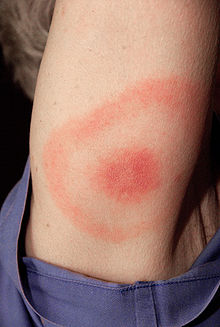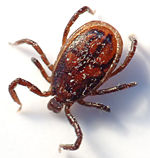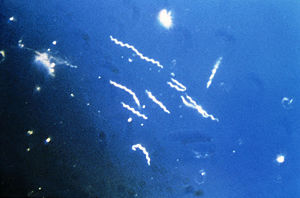OspA L03 Group2
From Proteopedia
Contents |
OspA: The Lead to a Cure for Lyme Disease
Introduction
Spirochetes and Lyme Disease
First recognized in 1957, Lyme disease has been estimated to affect between 20 and 100 cases per 100,000 individuals in the United States [1]. The peak infection rates of this disease occur approximately between the months of May and August in North America [2]. The causative agent for this disease is a bacterial vector of spirochetes, called Borrelia burgdorferi, which were found in the gut of the Ixodes tick. The bacteria spread through the bite of the tick forming severe skin lesions. Other health complications include chronic arthritis, and neurologic and cardiac abnormalities [3]. From 10-12 weeks of infestation, other symptoms like erythema chronicum migrans begin to appear as well [3]. Studies were first conducted through New Zealand white rabbits through the use of indirect immunofluorescence.
These spirochetes however do not enter the host through salivary gland secretions into the blood stream. The host becomes infected because the tick's blood meal enters the gut where the spirochetes are located where some of the blood that returns to the bitten area is infected with borrelia. This results in the transmission into the host's blood stream [2]). Once the bacteria is in the blood stream, the immune system may, or may not destroy this pathogen, depending on the presence of a vaccine. The type of proteins on the surface of the borrelia detected by the host's immune system determines the fate of the survival of this disease. One of the main outer surface proteins, OspA, plays a major role in the ability of the immune system to destroy these antigens [4].
About OspA
The Borrelia bacteria has proteins on its surface that are different in immunogenic expression [5]. One of these outer surface proteins, OspA, is a lipoprotein that was found to inhibit bacterial transmission [4]. OspA, known as a potent stimulator of nuetrophils, was able to kill the pathogen and attract leukocytes. The interaction of OspA on the antigen and the antibodies was a cascade complement system. Once the complement found OspA on borrelia, it induced an innate response of phagocytosis allowing the release of proinflamatory cytokines in a host [1] and avoid contracting Lyme disease as it affects the heart, joints, and central nervous sytem [1].
Pathology of OspA
Once entered the host through the skin or blood stream, Borrelia burgdorferi downregulated and suppressed OspA to minimize all of the host’s immunogenic characteristics [1], while expression of OspC was active. Usually, the initial stages of Lyme disease diagnosed individuals with peaked elevations of OspC up until 7-11 weeks, then later declined [5]). When OspA on the spirochete migrated to an inflammatory environment, it induced apoptosis on the bacteria through the activation of B-cells [1].
Structure
|
OspA
The model presented by the Protein Data Bank is OspA containing two light chains or Hybridoma Antibody LA2 (chains A and C), two heavy chains or Hyrbridoma Antibody LA2 (chains B and D), and two outer surface protein A (chains E and F). In addition, the original PDB image suggests that the C-terminal domain was unchanged by the LA-2 binding, other than minor shifts in the conformations of all 3-loops to accommodate interactions with the Fab [4].
LA-2
The reactive was found to serve as an important epitope of Osp-A binding [4] towards developing vaccinations. The protein, OspA obtained from PDB was dissected to isolate and concentrate the F chain from the molecule of OspA from the crystallized structure to show the free state of the 3D model exposing the C-terminal to express the interaction with the Fab antigen combing site exposing the 3-loops and 49 residues involved where LA-2 makes direct contact [4]. Studies were shown through findings from nuclear magnetic resonance, or NMR and crystallization [4].
Binding Sites
The following is the fit mechanism where the conformations recognize LA-2 and shifts to optimize the complementary antigen combing site [4]. There were 49 residues from the “three loops” involved that significantly affected by LA-2 binding, through findings from NMR and crystallization [4]. Residues 207 and 227 were excluded from analysis because of the peak overlap [4]. The portion of the protein chain detected through 15N-HSQC NMR that were affected by the binding of LA2 [4] was highlighted.” were represented by purple, were colored green and ” were colored aqua blue The cool coloring of the residues shows the location of LA-2’s direct contact on the “3 loops”. Primary colors were used to represent as orange and as yellow in spacefills for the primary or initial identification of the LA-2 epitope on the beta-strands. The coloration of resides are all at one end, C-terminal of the isolated OspA molecule showing the side where LA-2 binds. The rest of the model were beta-sheets that were left yellow, as the neutral color, and the only alpha-helix was colored pink, to show the general overall structure of 21 anti-parrallel beta-strands to 1 alpha-helix [4].
Vaccinations
OspA is the least variable protein located on the outer surface of the borrelia bacteria [4]. This results in fewer mutations to occur allowing the same vaccine to stay in use for a longer time. Individuals who were bit by an infected tick and received the ospA vaccine were able to produce anti-opsA antibodies. These antibodies enter the tick through its blood meal into the gut where spirochetes are found and are destroyed by the antibody’s detection of opsA. Therefore, before the spirochete enters the host, it will be inactivated and Lyme Disease may be prevented [6].
The complement system of the host also has a beneficial effect on destroying the borrelia located in the tick’s gut. It works by opsonizing these pathogens and attracting leukocytes which are a main component of the defense system against pathogens [1]. Overall, the large percentage of the antibodies raised during the OspA vaccination must bind to antigen surfaces that overlap with the LA-2 epitope [4] in order for the Borrelia bacteria to enter apoptosis.
Side Effects
Recent studies however have shown that neurological complications may appear in patients with this vaccination. This occurs because the down regulation of OspA from the vaccine would not be an abundant amount to activate the immune system for defense [6]. This may then cause a wide range of adverse events such as headaches and acute neuroborreliosis [6].
Past Experiments on the Effects of OspA
Experiments were done using mice to test the effects of OspA on Borrelia bacteria as Lyme diseases progressed in the host. Only when OspA expression was positive the borrelia bacteria in the host admitted to apoptosis. When the outer surface protein was not present the Borrelia bacteria survived and the mice later suffered through skin lesions [4]. On the other hand, if the vaccine with OspA is administered, or the bacteria has moved to a different environment of the cerebrospinal fluid or an inflammatory environment, the bacteria will activate and start to regulate OspA [4] by activating B-cells. Later this induced astrogliosis.
- ↑ 1.0 1.1 1.2 1.3 1.4 1.5 1.6 Rupprecht TA, Koedel U, Fingerle V, Pfister HW. The pathogenesis of lyme neuroborreliosis: from infection to inflammation. Mol Med. 2008 Mar-Apr;14(3-4):205-12. PMID:18097481 doi:10.2119/2007-00091.Rupprecht
- ↑ 2.0 2.1 2.2 Onrust SV, Goa KL. Adjuvanted Lyme disease vaccine: a review of its use in the management of Lyme disease. Drugs. 2000 Feb;59(2):281-99. PMID:10730551
- ↑ 3.0 3.1 3.2 Burgdorfer W, Barbour AG, Hayes SF, Benach JL, Grunwaldt E, Davis JP. Lyme disease-a tick-borne spirochetosis? Science. 1982 Jun 18;216(4552):1317-9. PMID:7043737
- ↑ 4.00 4.01 4.02 4.03 4.04 4.05 4.06 4.07 4.08 4.09 4.10 4.11 4.12 4.13 4.14 4.15 Ding W, Huang X, Yang X, Dunn JJ, Luft BJ, Koide S, Lawson CL. Structural identification of a key protective B-cell epitope in Lyme disease antigen OspA. J Mol Biol. 2000 Oct 6;302(5):1153-64. PMID:11183781 doi:10.1006/jmbi.2000.4119
- ↑ 5.0 5.1 5.2 Wagner B, Freer H, Rollins A, Garcia-Tapia D, Erb HN, Earnhart C, Marconi R, Meeus P. Antibodies to Borrelia burgdorferi OspA, OspC, OspF, and C6 antigens as markers for early and late infection in dogs. Clin Vaccine Immunol. 2012 Apr;19(4):527-35. Epub 2012 Feb 15. PMID:22336289 doi:10.1128/CVI.05653-11
- ↑ 6.0 6.1 6.2 6.3 Marks DH. Neurological complications of vaccination with outer surface protein A (OspA). Int J Risk Saf Med. 2011;23(2):89-96. PMID:21673416 doi:10.3233/JRS-2011-0527



